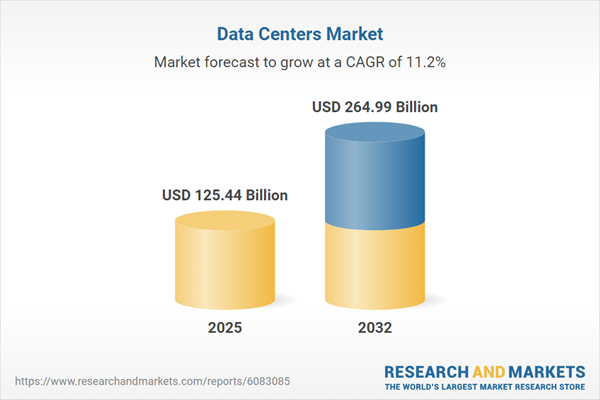Speak directly to the analyst to clarify any post sales queries you may have.
The data centers market is experiencing transformative change as organizations worldwide seek resilient, efficient, and sustainable digital infrastructure. This report offers an in-depth perspective designed for decision-makers evaluating opportunities, risks, and best practices across the evolving landscape of mission-critical facilities.
Market Snapshot: Growth Trends and Dynamics in the Data Centers Market
The data centers market grew from USD 113.14 billion in 2024 to USD 125.44 billion in 2025. It is expected to continue growing at a CAGR of 11.22%, reaching USD 264.99 billion by 2032. Market expansion is propelled by increasing digital workloads, advanced cloud adoption, and a heightened focus on sustainability initiatives. As organizations invest in mission-critical infrastructure, the sector is witnessing the convergence of AI workloads, edge computing, and integrated energy solutions.
Scope & Segmentation
This report delivers comprehensive analysis and forecasts across major market segments, providing actionable detail for decision-makers:
- Component: Hardware (networking equipment such as firewalls, load balancers, routers, switches; power and cooling infrastructure; racks and enclosures; servers including blade, rack, and tower servers; storage devices), Services (managed and professional services), and Software (backup and disaster recovery, cloud management, data center infrastructure management, security, virtualization).
- Data Center Type: Colocation, edge, enterprise, and hyperscale data centers.
- Tier: Tier I, II, III, and IV classified facilities, aligning with redundancy and resiliency requirements.
- Cooling Type: Air cooled (computer room air conditioning, computer room air handler) and liquid cooled (direct-to-chip cooling, immersion cooling) approaches.
- Power Source: Grid-powered and renewable-powered operations.
- End User: Banking, finance and insurance, government, healthcare, IT and telecom, manufacturing, retail and etail industries.
- Organization Size: Large enterprises and small & medium enterprises (SMEs).
- Region: Americas (United States, Canada, Mexico, Brazil, Argentina, Chile, Colombia, Peru), Europe, Middle East & Africa (including United Kingdom, Germany, France, Italy, Spain, Russia, Netherlands, Sweden, Poland, Switzerland, UAE, Saudi Arabia, Qatar, Turkey, Israel, South Africa, Nigeria, Egypt, Kenya), and Asia-Pacific (China, India, Japan, Australia, South Korea, Indonesia, Thailand, Malaysia, Singapore, Taiwan).
Coverage also encompasses analysis of leading data center providers and infrastructure partners to reveal competitive dynamics and innovation drivers.
Key Takeaways for Senior Decision-Makers
- Edge computing and distributed architectures are reshaping traditional models, requiring data centers to prioritize proximity, latency reduction, and flexible scalability.
- The proliferation of AI and machine learning workloads is spurring a shift toward high-density, flexible infrastructure and advanced cooling techniques to support evolving power and thermal demands.
- Software-defined, hyperconverged, and modular deployment strategies are reducing operational risk and streamlining resource allocation for maximum efficiency.
- Integrating renewable energy sources and energy-efficient cooling solutions is now critical to achieving sustainability mandates and controlling long-term operational costs.
- Organizations must increasingly address overlapping physical and cyber security challenges, adopting holistic design and monitoring solutions for compliance and risk management.
- Sophisticated segmentation and classification strategies allow stakeholders to align investments with sector-specific demands and growth drivers, maximizing market relevance.
Tariff Impact: Adapting Supply Chains and Vendor Strategies
The United States' 2025 tariff measures are prompting hardware vendors and infrastructure providers to reevaluate global sourcing, design components for reduced tariff exposure, and strengthen localized supply chain resilience. Organizations are adopting dual-sourcing, nearshoring tactics, and adjusting procurement models to buffer against price volatility and maintain uninterrupted deployment schedules.
Methodology & Data Sources
Findings are grounded in multifaceted primary research, including executive interviews and facility assessments, and are validated through secondary reviews of regulatory filings, peer-reviewed journals, and proprietary market data. A robust triangulation and expert validation process ensures accuracy and strategic relevance for operational leaders.
Why This Report Matters
- Enables data-driven planning by illuminating major trends across technology, sustainability, and regulatory domains.
- Equips senior leaders with actionable frameworks to future-proof data center investments and organizational strategies.
- Helps align supply chain, procurement, and technology adoption with dynamic market conditions and evolving stakeholder expectations.
Conclusion
This analysis equips stakeholders with a structured, forward-looking view of the data centers market. By leveraging the findings and recommendations presented, decision-makers can shape resilient, efficient, and compliant data center strategies for future growth.
Table of Contents
3. Executive Summary
4. Market Overview
7. Cumulative Impact of Artificial Intelligence 2025
Companies Mentioned
The companies profiled in this Data Centers market report include:- Amazon Web Services, Inc.
- Atos SE
- Aurecon Group Pty. Ltd.
- Cannon Technologies Ltd.
- Cisco Systems, Inc.
- Coromatic Group AB
- Datapod
- Dell Technologies Inc.
- Delta Electronics, Inc.
- DXN Limited
- Eaton Corporation PLC
- Fuji Electric Co., Ltd. by Furukawa Group
- Hewlett Packard Enterprise Company
- Hitachi, Ltd.
- Huawei Technologies Co., Ltd.
- International Business Machines Corporation
- Microsoft Corporation
- Mitsubishi Heavy Industries, Ltd.
- NVIDIA Corporation
- Oracle Corporation
- Rittal GmbH & Co. KG
- Schneider Electric SE
- SRA Solutions
- Stulz GmbH
- Vertiv Group Corporation
- Zella DC
- ZTE Corporation
Table Information
| Report Attribute | Details |
|---|---|
| No. of Pages | 183 |
| Published | November 2025 |
| Forecast Period | 2025 - 2032 |
| Estimated Market Value ( USD | $ 125.44 Billion |
| Forecasted Market Value ( USD | $ 264.99 Billion |
| Compound Annual Growth Rate | 11.2% |
| Regions Covered | Global |
| No. of Companies Mentioned | 28 |









